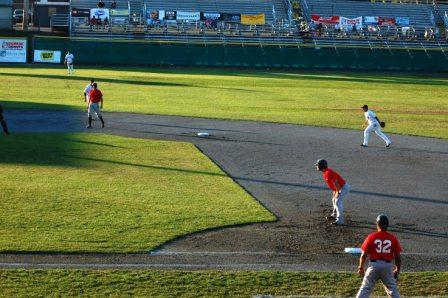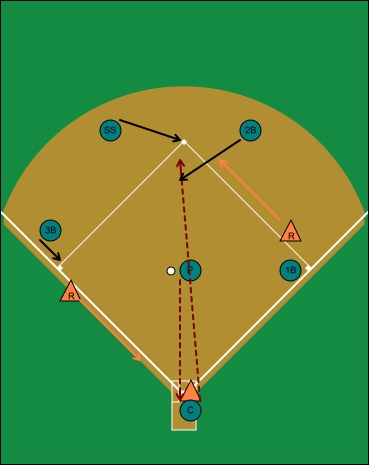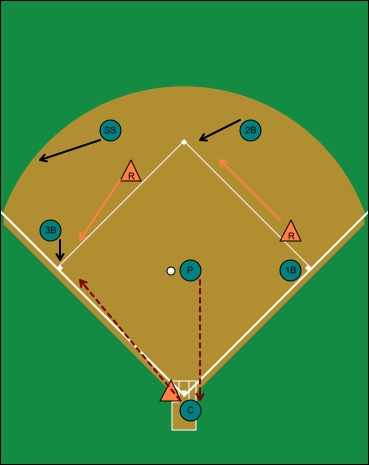|
Double Steals ~ Working To Keep Up The Pressure, Get Two Runners Into Scoring Position, or possibly score a run!
Photo Bill Stanton

Double steals, working to keep up the pressure, get two runners in scoring position, or possibly score a run.
The double steal puts a great deal of pressure on the infield defense, particularly with runners on first and third.
In either situation, once the offense starts those runners, the defense immediately has multiple problems to deal with. The first is a runner or runners stealing a base(s). Because there is a pitch and a batter, the potential is there for a bunt, bunt and run, hit and run, fake bunt and hit, or a created play worked between the runners, with no batter input.
The beauty of it all is that the defense, on the pitch delivery, does not know the offense's intent, thus creating some delay in their decisions. Instant advantage to the offense.
Each time the defense is pressured, that window of opportunity for mental and physical mistakes starts to open.
The more the offense is willing and able to do, the wider that window opens and the harder they become to defense.
It can become that proverbial "snowball rolling downhill" for a defense.
Runners On First And Third

- The centerpiece of this base running situation, designed to score the run from third and put another runner in scoring position.
- The runner from first is getting a good jump, stealing second base.
- The runner at third base is reading the throw by the catcher, if he gets a jump he is going to the plate.
- There are a few wrinkles the offense can put into this initial first and third double steal. These special plays create a lot of disruption within a defense.
Runners On First and Second

- Runners are going on the pitch, straight steal.
- Lead runner should attempt to get a walking lead into the steal, for the best advantage.
- Not as common a play in this base running setup as the first and third; but still very effective if pitcher is not paying attention to the runner at 2B, or is locked into looking a set number of times before delivering the pitch.
- Having the batter fake a bunt, drawing the bat back at the catchers eye level, can help keep the catcher back, increasing the runners chances.
Double Steal Tips ~ From The Dugout

Hitters can set up deep in the box, keeping the catcher as far back as possible. If you have added a bunt to this steal, hitter should move up in the box to increase his chances of bunting the ball fair.
A defensive play is at least 5 times as difficult to make as an offensive play, you have the advantage.
Study the pitchers so that you get good jumps, making it even harder on the defense.
Additional Offensive Situations
- Offensive Situations
~ Keep your opponents under pressure at all times
- Sacrifice bunts
~ The cornerstone's of offensive situations
- Hit and run
~ Get your offense moving with this exciting and aggressive play
- Bunt and run
~ The short game adrenelin rush
- Fake bunt and steal
~ A great wrinkle to enhance the straight steal, providing your base runner with a little extra protection
- Fake bunt and hit
~ An effective way to get the defense to react to what they see, then the offense executes something entirely different
- Reading down angles
~ Get the jump on pitches in the dirt, take the extra base
- Special plays
~ Designed to amp up your running game through the element of surprise
- Safety squeeze, Suicide squeeze, Double squeeze
~ Initially the safest version, yet the most complicated to execute, a few seconds of pure excitement, the excitement of the suicide, with so much more
- Base running
~ One of the least taught, yet still one of the most important, even in the age of the aluminum bat
- Stealing second
~ As you step out into your lead, all the feelings intensify as you lock in on that one movement the pitcher is about to make, a movement that will send you speeding towards second base
- Stealing third
~ Often easier than stealing second
- Steal home
~ Always exciting and a true defensive demoralizer
- Delayed steal
~ Uses the element of surprise, a great equalizer
- Home to first
~ A full out sprint; remember, hustle never has a bad day
- First to second
~ Stay in the moment, be aggressive
- Second to third
~ The base runners first and foremost responsibility is to keep track of the baseball
- Third to home
~ The exception in leadoffs, as you lead off in foul territory
- First to third
~ The added skill involved is to pick up the third base coach, then second base, and the coach again
- 25 ways to score
~ 25 reasons to work hard getting a runner on third base
return from double steals to the ole ballgame.com
|
Have A Baseball Related Question?
 Click the image to visit our question page and have it answered. Due to my increased coaching schedule, I would ask that questions be limited to the following categories: Baseball Instruction, Baseball's Mental Game and Defensive and Offensive Situations. Don't have a question right now? Maybe you'd like to browse through questions already submitted. Each question becomes it's own web page on this site. Step up to the plate and put the ball in play! It only takes a few minutes. Solid resources for other categories: Baseball Resource
|








